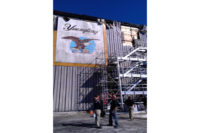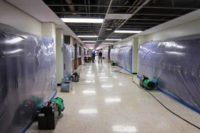Cleanup Work Extensive on 100,000 Sq. Ft. Superstorm Sandy-hit Warehouse
The 100,000-square-foot, Class A office and warehouse space experienced devastating water and structural damage in the aftermath of Hurricane Sandy












In October 2012, Paul Davis National responded to an emergency services call for structural cleanup, water damage restoration, stabilization and drying services at Coilhose Pneumatics in East Brunswick, N.J. The 100,000-square-foot, Class A office and warehouse space experienced devastating water and structural damage in the aftermath of Hurricane Sandy, followed by another storm with snow and melting water just one week later. The catastrophic winds during Hurricane Sandy peeled the roof off of the building, allowing water to pelt the exterior and pour into interior areas. The second storm caused even further damage to the building as a result of more rain and melting snow. Paul Davis National completed the initial stabilization work within one week to keep the air tool accessories and air line controls manufacturer and distributor running with little downtime. The customer’s administrative teams and IT departments were able to operate almost immediately. While crews worked 24/7, the Coilhose employees and equipment were relocated to alternating sides of the building until restoration work was completed.
According to J. Murphy, co-owner of Paul Davis National, the firm served as the general contractor with 35 crew members, technicians and local subcontractors. The team worked with Coilhose Pneumatics’ President Marvin Aaron, as well as key staff and insurance adjusters, to provide restoration and emergency mitigation services in the aftermath of this historic event.
The local Paul Davis office received the emergency call from Aaron almost immediately after the initial devastation to his family business. Aaron was referred to Paul Davis by his insurance carrier and from there contacted the large loss experts at the company. Murphy responded immediately to assess the damage. The company had long-time vendors who normally helped with renovations, construction and HVAC work. However, since Hurricane Sandy impacted everyone living and working in the area, tradesmen were unavailable and equipment was in short supply. The business had immense structural damage, as well as other problems caused by high winds, rain and flooding, making the need for repair immediate.
Crews and equipment converged on the job quickly for emergency services, repairs and restoration. Areas with the most damage included the front office, IT and shipping and receiving. Specifically, high winds during Hurricane Sandy tore large sections of the roof off of more than 40% of the building, mostly over the office areas. The building was without power for approximately one week. During this time, the rains during Sandy along with a “nor’easter” snow storm that followed a week later caused 50% more damage with extensive water throughout the offices and large portions of the warehouse. Tractor trailers and hundreds of pieces of equipment were housed on-site and used to mitigate the damage. Murphy directed his team to bring in equipment, including desiccant drying equipment, LGR dehumidifiers, air movers, portable extractors, trash pumps, HEPA vacs, air scrubbers and more.
Mitigation crews started immediately after the storm and worked 24/7 on both the inside and exterior of the building simultaneously. Roofing crews started temporary coverings and board-ups while contents crews started disassembling all furniture and pack-out of interior office contents.
Murphy decided that emergency services work could be done with Coilhose staff operating in offices in sections with less damage, while crews and technicians completed the mitigation and reconstruction functions in the heavily damaged areas. After crews completed the front half of the building, contents crews moved all furniture from the back area to the newly completed areas, allowing work to begin in the less damaged sections. Once sections of the building were completed, workers moved all furniture and reinstalled all office partition panels as originally positioned. The reconstruction functions took approximately two months to complete and included sheetrock, drywall, carpet replacement and painting.
After the reconstruction work was completed, the team cleaned and sterilized 100% of the building to contain and control the microbial growth and ensure a healthy and safe environment.
“This was a challenging project during a historic storm event in our country,” Murphy said. “We had to quickly assess the damage to start the work and complete critical parts of the job immediately to keep the business up and running. To add to the complexity of the job, accessing local equipment was difficult and we had to transport most of the equipment from outside of the market area due to local business and supply constraints.”
The situation was brought under control quickly and effectively through emergency response support. “This type of unexpected loss is not predictable and a response strategy had to be organized and managed immediately,” Murphy says. “There were many times when the situation was critical and innovations were required. The documentation we provide ensures efficient cost containment. Our objective is to operate the loss site proficiently and utilize the latest methods available before implementation.”
Looking for a reprint of this article?
From high-res PDFs to custom plaques, order your copy today!











